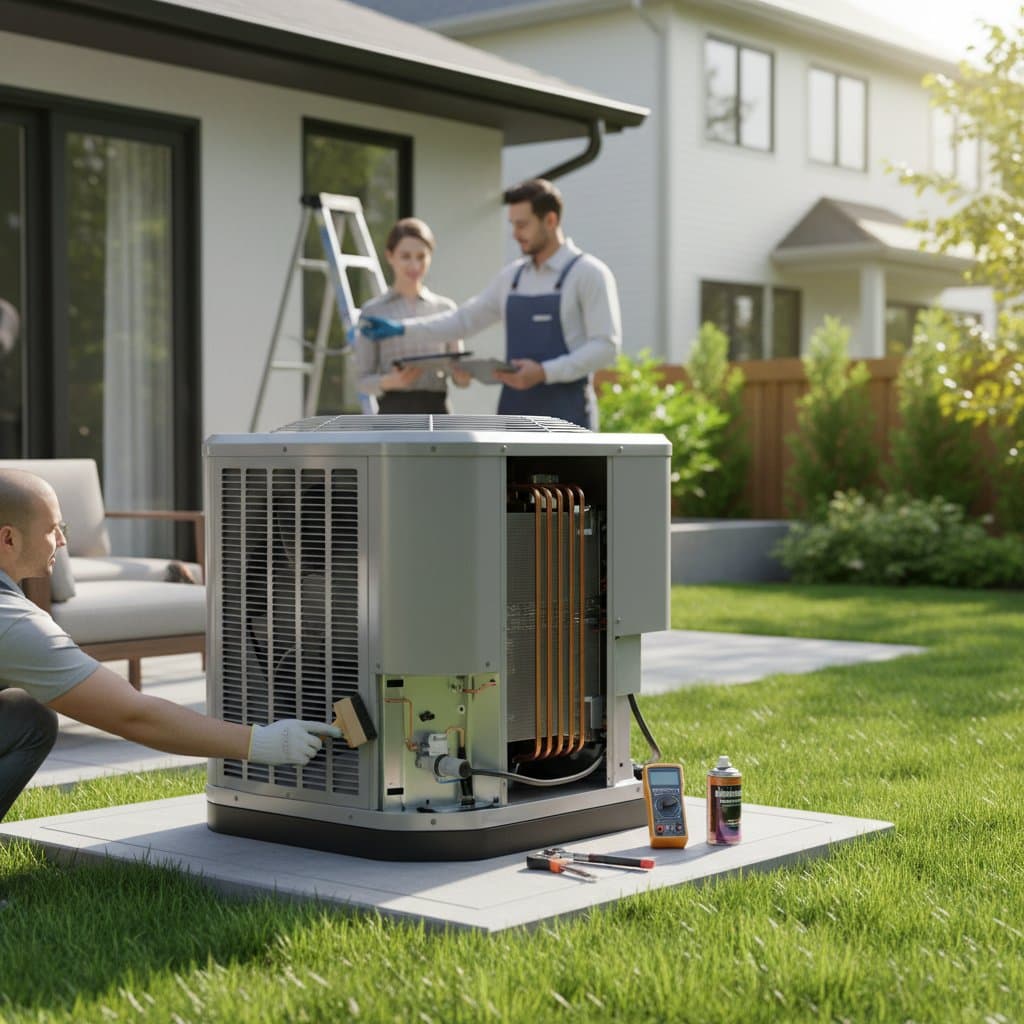Why AC Maintenance Matters Before Summer Arrives
Air conditioning systems face intense demands during hot months, leading to potential failures if neglected. Regular maintenance ensures optimal performance, prevents unexpected breakdowns, and maintains indoor comfort. Homeowners who address these tasks early avoid costly repairs and enjoy lower utility bills.
Summer heatwaves strain AC units, causing components to overwork and efficiency to decline. Without proper care, issues like reduced airflow or refrigerant leaks emerge, resulting in higher energy use and discomfort. Proactive steps safeguard the system and extend its operational lifespan.
Identifying Common Summer AC Problems
Many AC breakdowns stem from preventable issues that accumulate over time. Dirty air filters restrict airflow, forcing the unit to labor harder and increasing wear on the compressor. Clogged condenser coils outside accumulate debris, which impairs heat dissipation and raises operating temperatures.
Ductwork leaks allow cooled air to escape, diminishing overall efficiency and straining the system. Low refrigerant levels, often due to undetected leaks, reduce cooling capacity and can damage the compressor. Electrical problems, such as faulty wiring or capacitor failures, pose safety risks and lead to sudden shutdowns.
Ignoring these signs invites major disruptions during peak heat. Early detection through routine checks allows for simple fixes before problems escalate. Understanding these vulnerabilities empowers homeowners to act decisively.
Step-by-Step Maintenance Guide
Follow this structured approach to prepare your AC for summer. Each step builds on the previous one, creating a comprehensive routine that enhances reliability.
1. Replace or Clean Air Filters
Air filters capture dust, pollen, and debris, but they become clogged after months of use. Inspect filters monthly and replace them every one to three months, depending on usage and air quality. For reusable filters, vacuum them gently or wash with mild soap and water, then allow full drying before reinstalling.
Clean filters improve airflow by up to 15 percent, reducing strain on the blower motor. This simple action lowers energy consumption and maintains consistent cooling. Select filters with a MERV rating of 8 to 13 for balanced filtration without excessive resistance.
2. Clean the Condenser and Evaporator Coils
Outdoor condenser coils collect dirt, leaves, and grass clippings, which insulate the unit and hinder heat release. Turn off power to the AC, then use a garden hose with low pressure to rinse the coils from the inside out. Avoid bending the fins; use a soft brush for stubborn spots.
Indoor evaporator coils, located in the air handler, develop mold and dust buildup. Access them by removing the access panel and applying coil cleaner spray, followed by a gentle rinse. Clean coils restore heat transfer efficiency, potentially cutting energy use by 20 to 30 percent.
3. Inspect and Seal Ductwork
Leaky ducts waste up to 30 percent of cooled air, driving up costs and uneven temperatures. Examine visible ducts in attics, basements, and crawl spaces for gaps, tears, or disconnected joints. Seal them with mastic sealant or foil tape, ensuring all connections remain secure.
Professional duct testing with a blower door can pinpoint hidden leaks. Proper sealing distributes air evenly, improves humidity control, and eases the load on the AC unit. Address insulation on ducts in unconditioned spaces to prevent condensation and energy loss.
4. Check Refrigerant Levels and System Pressure
Refrigerant circulates to absorb and release heat, but leaks deplete levels over time. Look for signs like warm air from vents or ice on coils, which indicate low refrigerant. Use a gauge set to measure pressure if experienced; otherwise, consult a technician for accurate assessment and recharge.
Maintaining proper levels prevents compressor damage and ensures efficient cooling. Annual professional checks verify compliance with environmental regulations on refrigerants. This step sustains the system's cooling power through extended summer use.
5. Examine Electrical Components and Thermostat
Loose wiring or corroded connections increase fire risks and cause intermittent failures. With power off, inspect terminals for tightness and clean corrosion with a wire brush. Test the capacitor and contactor for proper function using a multimeter if skilled in basic electrical work.
Upgrade to a programmable or smart thermostat for precise temperature control and energy savings. Calibrate it to avoid short cycling, which wears out the system prematurely. Reliable electrical integrity supports uninterrupted operation during heat peaks.
6. Schedule a Professional Tune-Up
While DIY tasks cover basics, experts handle complex diagnostics with specialized tools. Annual tune-ups include combustion analysis for gas furnaces, lubricant application to moving parts, and overall system balancing. Technicians identify wear early, preventing breakdowns that could cost thousands.
Choose certified HVAC professionals familiar with your unit's make and model. These services often include priority service agreements for summer emergencies. Investing in expertise yields long-term savings and peace of mind.
Maximizing Long-Term AC Performance
Integrate maintenance into a yearly calendar, aligning checks with seasonal changes. Track filter replacements and service dates in a log to monitor patterns. Combine AC care with home efficiency upgrades, such as ceiling fans or shading, to reduce runtime demands.
Monitor system performance through energy bills and airflow tests. Address any anomalies promptly to avoid compounding issues. These habits transform AC ownership from a liability into a reliable asset.
Benefits of Proactive AC Care
Consistent maintenance delivers immediate and lasting advantages. Systems run more efficiently, slashing cooling costs by 10 to 40 percent annually. Extended equipment life defers replacement expenses, often adding years to the unit's service.
Improved air quality from clean components reduces allergens and enhances health. Reliable operation eliminates sweltering disruptions, ensuring comfort for families and pets. Embrace these practices to navigate 2025 summers with confidence and efficiency.





